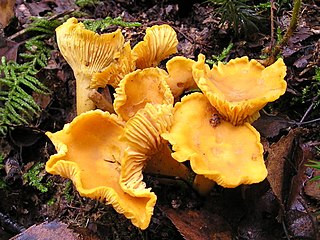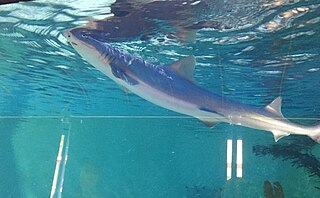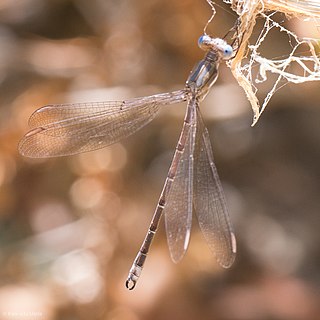
The purple finch is a bird in the finch family, Fringillidae.

Cantharellus cibarius is a species of golden chanterelle mushroom in the genus Cantharellus. It is also known as girolle. It grows in Europe from Scandinavia to the Mediterranean Basin, mainly in deciduous and coniferous forests. Due to its characteristic color and shape, it is easy to distinguish from mushrooms with potential toxicity that discourage human consumption. A commonly eaten and favored mushroom, the chanterelle is typically harvested from late summer to late fall in its European distribution.

The japygids are a taxon of hexapods, of the order Diplura, commonly known as forcepstails.

The gray smooth-hound is a houndshark of the family Triakidae. It is found on the continental shelves of the subtropical eastern Pacific, from northern California to the Gulf of California, between latitudes 40° N and 23° N, to a depth of 46 m. It can grow up to a length of 1.24 m.

Platystemon is a monotypic genus of flowering plants in the poppy family containing the single species Platystemon californicus, which is known by the common name creamcups. It is native to Oregon, California, Arizona, Utah and Baja California, and is found in open grasslands and sandy soils below 6,000 feet (1,800 m) elevation.

Sea cucumbers are marine animals of the class Holothuroidea. They are used in fresh or dried form in various cuisines. In some cultural contexts the sea cucumber is thought to have medicinal value.

The California mouse is a species of rodent in the subfamily Neotominae in the family Cricetidae. It is the only species in the Peromyscus californicus species group. It is found in northwestern Mexico and central to southern California. It is the largest Peromyscus species in the United States.

The California pocket mouse is a species of rodent in the family Heteromyidae.

Schoeneoplectus californicus is a species of sedge known by the common names California bulrush, southern bulrush and giant bulrush. It is also sometimes called "tule", but the closely related Schoenoplectus acutus is the species most often referred to by that name.

Californiconus californicus, common name the Californian cone, is a species of small, predatory sea snail, a marine gastropod mollusc in the family Conidae, the cone snails.
Occasjapyx is a genus of diplurans in the family Japygidae.
Neoseiulus californicus is a predatory mite that feeds on Tetranychid mites. This species was first described on lemons from California under the name Typhlodromus californicus in 1954.

The California myotis is a species of vesper bat. It is found in British Columbia in Canada, Guatemala, Mexico, and in the western United States, including California.

Tapirus veroensis, commonly called the vero tapir, is an extinct Tapir species that lived in the areas of modern-day Florida, Georgia, Kansas, Missouri, and Tennessee. Tapirus veronensis is thought to have gone extinct around 11,000 years ago.
Occasjapyx americanus is a species of forcepstail in the family Japygidae. It is found in North America.
Occasjapyx carltoni is a species of forcepstail in the family Japygidae. It is found in North America.
Occasjapyx sierrensis is a species of forcepstail in the family Japygidae. It is found in North America.

Archilestes californicus, the California spreadwing, is a species of spreadwing in the damselfly family Lestidae. It is found in Central America and North America.
Physocyclus californicus is a spider in the family Pholcidae, in the infraorder Araneomorphae . The distribution range of Physocyclus californicus includes the USA and Mexico.
Ambrysus californicus is a species of creeping water bug in the family Naucoridae. It is found in North America.












